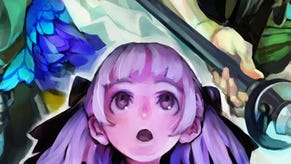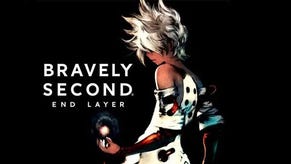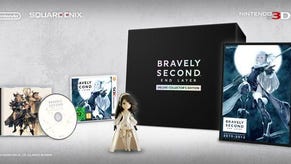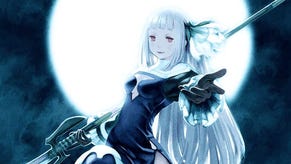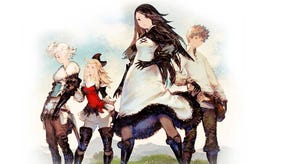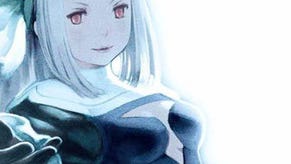Bravely Second: End Layer Nintendo 3DS Review: Welcome Back, Warriors [Updated With Final Score!]
Bravely Second should feel very familiar for fans of Bravely Default, and that's perfectly OK.
This article first appeared on USgamer, a partner publication of VG247. Some content, such as this article, has been migrated to VG247 for posterity after USgamer's closure - but it has not been edited or further vetted by the VG247 team.
If you played Bravely Default through completion, then you've probably been champing at the bit for Bravely Second: End Layer since 2013. You probably also won't be surprised to learn Bravely Second is very much a direct sequel to Bravely Default, both in terms of its story and its battle mechanics.
After all, you knew this was coming. You likely saw that cool teaser video at the end of the first game that let you know in no uncertain terms that Bravely Default's hero, Tiz, still has a lot of unfinished business to mop up. Maybe you watched the teaser again and again. Maybe you even found a way to liquefy it and bathe in it until Bravely Second's release.
If, however, you missed out on the teaser, or you didn't get around to finishing Bravely Default, or if you just want to jump into the franchise mid-ride, Bravely Second has you covered with a brief narrative that summarizes series' events up until the start of the new chapter.
Veterans are welcome to skip the cinema, of course. That's the nice thing about Bravely Second: Like its predecessor, you have a lot of control over the game's speed, delivery, and difficulty. Bravely Default and Bravely Second serve up a very traditional JRPG experience but hand you a knife in case you want to carve out tedious bits of the genre.
In other words, if you appreciate Bravely Default on any level, you'll have no problem getting comfy with Bravely Second. The reverse holds true, too: If Bravely Default didn't carry you away, you'll find nothing appealing about Bravely Second. It's very much an extension of the first adventure, and while you can expect to see new faces and new jobs, you can also expect to see a lot of familiar sights, too.
Even the new characters feel a bit worn. Our new main character, Yew, comes from a common breed of JRPG hero-dork. He's not unlikeable -- my cynical black heart is already thawing in the aura of his exuberance -- but neither does he offer up a lot of surprises in the first few hours of gameplay. If you watch a lot of anime and play a lot of JRPGs, you have a good idea of what this guy's about.

Obviously, Yew and I have only just hit the road together. Maybe he'll pull a few tricks out of the bottomless item bag game heroes always seem to have handy. Who knows.
Yew and Bravely Second's other characters are backed up by voice actors who try hard, bless them, but sometimes fall flat because of awkward dialogue. You probably won't cringe too hard, though. Bravely Second more or less adopts the same tone as Bravely Default, so the story's dark moments are diluted with plenty of light banter and humor in between.
Two of Bravely Default's most popular features are back for Bravely Second: The job system, as well as the option to "default" in battle. The job system is easy to grok if you played Bravely Default, or even if you're just familiar with how jobs work in Final Fantasy games that emphasize the system (Final Fantasy V, for instance). When you beat a boss character, you gain that boss's "asterisk," enabling you to switch to their class. As you fight, you learn skills exclusive to that particular job, and can keep using them even if you switch to another job.

Needless to say, Bravely Default and Bravely Second both have a nutty amount of character customization. You can spend hours just putzing around with jobs and skills. Don't feel intimidated, though. There's really no right or wrong way to go adventuring. It's all about finding what you're comfortable with. And if you do feel a little uneasy with how battles are going, you can switch Bravely Second's difficulty level any time you want.
That probably won't be necessary, as the early hours of Bravely Second are obviously tooled to be friendly for newcomers. This gentle introduction gives you plenty of time to learn how to default, an action that's usually unnecessary against vanilla enemies but will save your bacon when you're up against a boss.
Defaulting is, simply, defending. However, defaulting also adds a point to your BP meter, which depletes with every action you make (aside from defaulting, of course). You can, for instance, defend for one turn, then attack twice on the next turn. Or you can defend on one turn, then use your next turn to attack once, and heal once.
Or you can go for broke and opt to "brave," which lets you queue up four actions at once. If you don't have the necessary amount of BP, you can operate at a deficit up to -4. This can be quick way to end a battle, but it can also leave you standing around like an idiot for four turns while the enemy you couldn't quite finish off kicks you around.
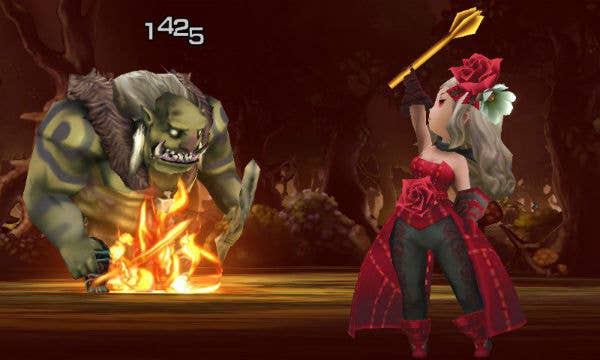
Enemies and bosses are ruled by BP as well, so survival is a matter of reading your foes' intentions and reacting accordingly. Again, Bravely Second's customizable battle speeds are a big help. Braving and auto-battling help you blaze through the grind sessions that are necessary to build up your levels and jobs, but you can take boss fights as slowly and as steadily as you like.
If you never played Bravely Default and Bravely Second sounds complicated and frightening, don't be worried for even a second. The game explains things succinctly but thoroughly via instructions and notes you can access at any time, and it even offers you rewards for completing tutorial-related quests.
I've only just burrowed into Bravely Second's crust, so I obviously need more time before I can dole out my final impressions on the game and assign a score. But even the brief spell I've spent with the game gives me enough confidence to recommend it to fans of Bravely Default. There aren't a whole lot of new ideas on parade here, but given what a treat the first outing proved to be, maybe "more of the same" is perfectly acceptable.
Lasting AppealBravely Second is a long game, though you have some control over how many hours you want to pour into it (you're not obligated to schlep around the world in search of every last job asterisk, for example). If you're a job fanatic, you can toy with learned skills forever in search of your favorite build.
SoundSupercell band member Ryo takes over for Bravely Default's Revo, and everything sounds great -- though whether or not Bravely Second sounds "better" than Bravely Default is a matter of preference in the end. There's no arguing the battle theme for the Ba'als is delightfully weird and creepy, though.
VisualsAkihiko Yoshida's character designs are at their best here, and the enemies you go up against are creative and well-animated. The adorability of the costumes for each job class cannot be overstated, either. I still can't get over the Merchant class's tophats, bonnets, and stupid bling-bling clock necklaces. The characters wear their costumes in cutscenes, too!
ConclusionBravely Second: End Layer is a worthy follow-up to Bravely Default, which in itself is one of the best RPGs on the Nintendo 3DS. Granted, if Bravely Default didn't move you the first time around, Bravely Second probably won't, either. For better or worse (but mostly better), it's a straight-up second helping of its predecessor.
Part 2
A procession of weirdly-timed circumstances kept me from polishing off Bravely Second and this review as quickly as I initially would've liked. Please don't hold the delay against Yew, or take it as an indication that I didn't enjoy myself. On the contrary, Bravely Second is a joy.
And, to repeat myself, it just feels good to have a classic JRPG experience with an adjustable "old school" meter. Are random encounters getting you down while you navigate through labyrinthine dungeons? Turn them off for a bit. Need to grind? Fight several battles in a row to multiply your experience earnings.
Simply put, Bravely Second is a successful blend of old JRPG values and new ideas. This point is demonstrated through the game's job system alone, which offers a grand mix of old favorites (Knight, White Mage, Black Mage, Thief, Monk) and new vocations that are so bizarre, you're helpless to keep your hands out of them (Catmancer, Patissier, Exorcist, Yokai).

Obviously, not every job is built around turning your character into a murder machine. You're probably asking "How the heck am I supposed to kill bad guys by throwing cake at them?" You're right to do so, but a big chunk of Bravely Second's enjoyment comes from seeing how classes complement one another. The Patissier, for instance, supports their fellows by lobbing stat-lowering foods at foes.
"So the Patissier specializes in buffs and debuffs? What's wrong with just casting regular spells to do the same thing?"
Because that's not as much fun. Besides, there are other jobs based around buff and debuff magic -- the Astrologian, for instance -- but the Patissier literally crafts a sweet before they whip it at a bad guy. In the same vein, Catmancers learn enemies' moves by observing them, essentially making them Bravely Second's Blue Mages. The twist is that cats are coaxed into mimicking said attacks by being fed certain items, like "Dragon Steak" and "Leviathan Sashimi."
It's easy to glance at Bravely Second and decide it never takes itself too seriously. And while Bravely Second undeniably puts its sense of humor above all else, it's also important to point out you have some control over how thickly the game lays it on. Don't want a party full of cupcake-hurling cat-whisperers (you monster)? That's fine. You're hardly working with a handicap if you opt for traditional Dark Knights and Red Mages.

Bravely Second makes no secret of its light mood, same as it's wide-open about its preference for improvement over innovation. Instead of introducing a slew of new ideas, Bravely Second polishes its predecessor's rough spots, then offers up more of everything that worked the first time around. More jobs. More characters. More options to keep ye olde JRPG mechanics from becoming too much of a grind. More searching. More side-quests.
Oh, there is less of one thing: Less threadbare anime jokes about dirty old men hitting on young ladies. Hopefully, your heart will go on.
If you avoided Bravely Default because you found the first one too twee or you just weren't a fan of its core mechanics, you can dodge Bravely Second without regret. If, however, you enjoyed the first game but found its end game a massive slog, you'll be pleased to know Bravely Second is a tighter, sleeker experience all around.
And if you simply enjoyed bravely defaulting in the face of your foes the first time around, don't hesitate to pick up Bravely Second. Go for the gravy.
Lasting AppealBravely Second is a long game, though you have some control over how many hours you want to pour into it (you're not obligated to schlep around the world in search of every last job asterisk, for example). If you're a job fanatic, you can toy with learned skills forever in search of your favorite build.
SoundSupercell band member Ryo takes over for Bravely Default's Revo, and everything sounds great -- though whether or not Bravely Second sounds "better" than Bravely Default is a matter of preference in the end. There's no arguing the battle theme for the Ba'als is delightfully weird and creepy, though.
VisualsAkihiko Yoshida's character designs are at their best here, and the enemies you go up against are creative and well-animated. The adorability of the costumes for each job class cannot be overstated, either. I still can't get over the Merchant class's tophats, bonnets, and stupid bling-bling clock necklaces. The characters wear their costumes in cutscenes, too!
ConclusionBravely Second: End Layer is a worthy follow-up to Bravely Default, which in itself is one of the best RPGs on the Nintendo 3DS. Granted, if Bravely Default didn't move you the first time around, Bravely Second probably won't, either. For better or worse (but mostly better), it's a straight-up second helping of its predecessor.


